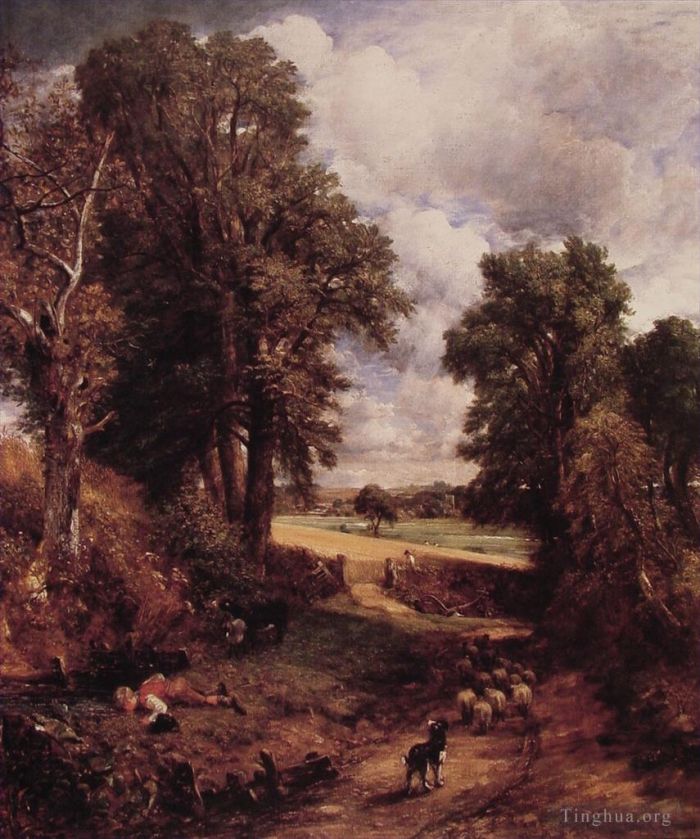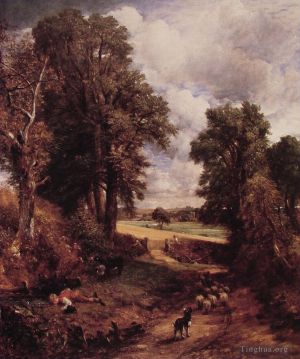The Cornfield
John Constable
- Price: Price on Request
- Art Type: Oil Painting
- Size:
- English Comments: 0
- International Comments: 0
- Creating Date:
- Introduction and Works of John Constable >>
Keywords:
Cornfield
Work Overview
- The Cornfield
1826
John Constable
Oil on canvas
143 x 122 cm
The Cornfield is an oil-on-canvas painting by the English artist John Constable. It was finished in 1826 and was first exhibited at the Royal Academy that same year. It measures 143 by 122 cm. It is in the National Gallery, London.
Constable referred to the painting as The Drinking Boy. It shows a lane leading from East Bergholt towards Dedham, Essex.
The title seems first to have been used by the subscribers who presented the picture to the National Gallery. Constable referred to it familiarly as 'The Drinking Boy'. It probably shows a lane leading from East Bergholt towards Dedham; the distant church could be an invention.
The painting was exhibited several times during Constable's lifetime, first at the Royal Academy in 1826.
In this wonderful landscape, Constable departs from his usual river scene to paint a path through a dense wood, leading out to a field ripe with grain. In England, all grain is called "corn," hence the name of the painting is The Cornfield. It is not, of course our corn, which the British call maize, or Indian corn.
Constable's touch of red, this time, is found on the vest of a young shepherd who has temporarily abandoned his sheep to the care of the dog, while he crouches down on his stomach to examine a little creek, and perhaps take a drink. The sheep are hidden in the shadows, as are the workers in the field beyond, who are cutting down the ripened grain.
Despite the care with which Constable has composed the scene -- the artful arches of the trees and the glaring sunlight on the grain are outstanding -- the impression is of a "spot of time," a unique glimpse that will never return. This was Constable's aim: to show nature and humans in a moment of time.
The Cornfield is, today, one of Constable’s best-known works. It was also the first of his pictures to enter a public collection. Shortly after his death in 1837, a committee was set up to subscribe towards the purchase of a painting for the nation, and The Cornfield was bought for the National Gallery for 300 guineas. The list of subscribers included the poet William Wordsworth, the scientist Michael Faraday, and several artists.
This print of the subject was published in 1834, and was a great commercial success. However, Constable never found a buyer for the painting during his own lifetime.
- Copyright Statement:
All the reproduction of any forms about this work unauthorized by Singing Palette including images, texts and so on will be deemed to be violating the Copyright Laws.
To cite this webpage, please link back here.
- >> English Comments
- >> Chinese Comments
- >> French Comments
- >> German Comments
- >>Report
- Brighton Beach with Colliers
- A View on the Stour near Dedham
- A Church porch
- A Cottage in a Cornfield
- View Towards The Rectory From East Bergholt House
- Mrs James Pulham
- Weymouth Bay
- Spring Ploughing
- The Hay Wain
- Flatford Mill
- Flatford Mill (Scene on a Navigable River)
- Wooded Landscape
- A boat passing a lock
- Landscape Evening
- Landscape with a Double Rainbow
- Brighton WMM
- Wivenhoe Park
- Stratford Mill
- Harwich lighthouse
- A WaterMill
- Hadleigh Castle
- Flatford Mill from the lock
- View towards Dedham
- View of Dedham
- Dedham Vale
- Salisbury Cathedral from the Meadows
- Landscape Boys Fishing
- The Cornfield
- Scene on a River
- Malvern Hall
- Wivenhoe Park Essex
- Boat Building
- Cottage Rainbow Mill
- The Mill Stream
- Branch Hill Pond Hampstead
- Salisbury Cathedral from the Bishops Grounds
- Maria Bicknell
- Scene on a river2
- Tree trunks
- Golding Constables Flower Garden
- East Bergholt Rectory
- The Harvest Field
- Dedham Vale Morning
- The leaping horse
- Weymouth Bay2
- Evening Landscape at East Bergholt
- Landscape ploughing scene in Suffolk
- The Young Waltonians
- The Valley farm
- Shoreham Bay
- Ladies From The Family Of Mr William Mason Of Colchester Romantic women John Constable
- Hampstead Heath
- A Hayfield at East Bergholt
- Golding Constables Kitchen Garden a
- The White Horse









 Singing Palette
Singing Palette